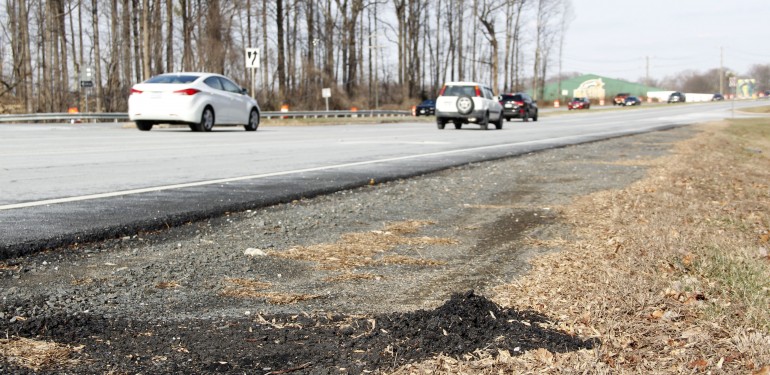(Photo credit: Amy Rose/Fourth Estate)
Before there was Mason…
This story is the first in a short series by Fourth Estate that explores what Mason’s campus looked like before it became the grounds for a university. Northern Virginia is rich with history, and we hope this series connects the Mason community to its vibrant past. Stay tuned as we discover the land and people that preceded our school.
During a routine county construction project last October, construction workers discovered a road that dates back to the Civil War on Ox Road in Fairfax County. This discovery has helped archeologists construct a better view of what Fairfax was like during the Civil War.
The type of road found was constructed of cedar logs and is referred to by historians as a “corduroy road,” a type of road that was common during the Civil War, according to Fairfax Historical Commission Member Mary Lipsey. In areas where there were formerly simple dirt roads, cedar-log highways were frequently constructed to combat the high amount of foot traffic generated by both the Union and Confederate armies during the Civil War.
The road is currently covered, but has been preserved. Archeologist Christopher Sperling was called to the scene when construction workers uncovered the road. Within 48 hours, the Virginia Department of Historic Resources had given the Fairfax County Historical Commission permission to investigate the road.
Sperling said that the road provided answers to some questions, such as the surface elevation of Fairfax County when the road was constructed, how it was constructed, how it was aligned as well as how it looked. Sperling said that there was ample time to study the road, adding, “we are fortunate in Fairfax County that the citizenry and government recognize the importance of heritage resources and support their preservation and interpretation.”
According to Sperling, discovering the road was a “rare” find, despite the fact that it is well known amongst historians that Fairfax County was an area where there was a lot of Civil War activity. He added that this was, in part, because of the suburban development that has occurred In Fairfax over the past several decades. Also, Sperling said, metal detecting became a very popular activity in the mid and late twentieth century. Civil War sites were favorite spots for enthusiasts, which caused many of these sites to be almost completely collected out of existence, he added.
“In this instance, we would have thought that the development and expansion of the roadway in the past would have resulted in the corduroy road having been destroyed. However, what we found was that, rather than demolishing the former road surface, it was buried and therefore preserved,” Sperling said.
Lipsey described Fairfax as a key location during the Civil War for both the Union and the Confederacy.
“[Route] 123 was a major corridor for both Union and Confederacy to get out to Centreville. [There were] a lot of skirmishes in the Herndon, Frying Pan area, Occoquan, near Burke Lake Park. Those would be the two main roads that surround George Mason,” Lipsey said.
Lipsey said another key location during the Civil War was Brimstone Hill, a historic building located at the intersection of Route 123 and Braddock Road. According to Lipsey, the last skirmish fought in Fairfax was fought there. The following day, Confederate General Robert E. Lee surrendered in Appomattox, Va.
Lipsey also mentioned the citizens of Fairfax at the time and their feelings toward the Union Army.
“The Union Army was marching through their yards and taking things, and most of these people were Confederate sympathizers,” Lipsey said.
According to Sperling, in 1861 the electorate in Fairfax County, which Sperling said consisted of “white, male, residents,” voted for succession and was occupied by Confederate forces in its western half. However, after the Battle of First Manassas, possession went back to the Union, though many Confederate sympathizers remained, and Confederate raids were common.
“Fairfax County was very strategic. The Orange and Alexandria Railroad connected Alexandria with the Shenandoah Valley, referred to as the breadbasket of the Confederacy. Many important roads crossed the county. Also, being so close to the federal capital, it needed to be secured,” Sperling said.
Sperling said that because of all this activity in Fairfax County, there are many historical sites that are often not publicized in order to help preserve them.
According to the Fairfax County Historical Society, the land where Mason now sits was owned by three people: Newman Burke, who owned 64 acres; Margaret Farr, owning 182 acres; and William Sagar, owning 284 acres. A cottage known as “Grandmas’s Cottage” that Farr lived in was located at the intersection of Old Lee Highway and Main Street until 2001, when it was moved to the Blenheim Plantation on Old Lee Highway.
Another historic site, Sager Avenue, a street that runs near the Old Courthouse in Old Town Fairfax, is named after the Sagar family. However, it has been a local point of contention that the street has been misspelled. However, in 2011 the city cited costs of changing the street sign as a reason not to change it, as well as other concerns.
As far as further excavation and investigation of the area go, Sperling says that there are no current plans.
“Although we now know that intact resources are present, our goal is primarily management, ensuring that any future development plans avoid the resource if possible or plan to mitigate the impacts, if not,” Sperling said. “Our office works very closely with various county, state, and federal agencies to identify projects that could impact sensitive archaeological and historical sites and determine the best course of action.”
Sperling continued that avoidance is always Fairfax County Historical Commission’s preferred outcome.
“Archaeological resources are each unique and non-renewable. Once they are gone, they are gone forever, and, these sites are often the only means we have to understand the lives of people that are not or under-represented in the historic record,” Sperling said. “Local, state, and federal policies and laws are in place to protect these resources or plan for their investigation if preservation is not possible.”




